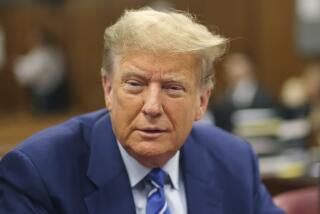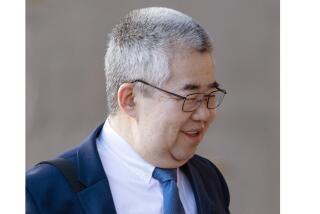TEXT OF SWORN STATEMENTS
Following are the texts of the signed, handwritten statement by Kathy Saxton-Calderwood, a juror in the retrial of Mayor Roger Hedgecock, and of a statement signed by San Diego attorney John N. Learnard regarding another juror. Learnard declined to name the juror but said he represented that juror in another legal case. Learnard represents juror Stanley J. Bohensky on other matters.
I, John N. Learnard, hereby declare that the following facts are true and correct and if called and sworn as a witness, could competently testify to the facts hereto.
I am an attorney duly licensed to practice law in the State of California before all courts.
On October 11, 1985, at about 11 a.m., I received a telephone call from a juror who deliberated in the Hedgecock case. The juror was upset about certain irregularities that had occurred during the jury’s deliberations held at the Hanalei Hotel, and has volunteered the following information:
1. According to the juror, about 4 days into deliberations, the bailiff informed the juror that they had been sequestered by Judge Todd because he did not want another hung jury.
2. That on or about the fourth day of deliberations, the bailiff, Al, gave an explanation regarding the definition of reasonable doubt to several members of the jury.
Not all of the members of the jury were present; however, the juror recalls at least three or four other people being present. At that time, Al explained the facts as they existed in a prior case, wherein the jury was hung. Al further informed the members of the jury who were present that the jury had to reach a unanimous decision one way or the other in that case. The juror felt that Al’s explanation of reasonable doubt and the explanation of the law helped the juror in arriving at the juror’s verdict.
3. A juror named Kathy asked Al whether or not there was a third alternative, that is, a hung jury, and Al indicated that there could not be a hung jury and the vote had to be unanimous. According to the juror, Kathy apparently complained to the female bailiff named Holly about what Al said, and the female bailiff told Al about Kathy’s having made a complaint.
4. On the following morning, Al came into the room where the juror was present and told the juror that Kathy had made a complaint and “to watch out for her because she is trouble.”
5. Al stated to some of the jury members on various occasions throughout the deliberations that they had to reach a unanimous verdict and vote one way or the other so that the matter could be resolved.
6. During the deliberations, Al informed the juror that Judge Todd and himself had already made up their minds, having sat through both trials. The juror felt that Al’s comment was meant to mean that the jury should reach the same decision.
7. The juror remembers that the bailiff came into the juror’s room on several occasions and spoke to the juror in confidence about the jury deliberations. Al stated, “I know I can trust you.”
8. The juror felt that none of the jurors would be able to go home until they reached a unanimous verdict.
9. The bailiff, Al, asked the juror to keep a list of the unreasonable jurors and give him this information. The juror acted accordingly by reporting to Al the names of the unreasonable jurors and had the documentation in the juror’s notebook, which was kept by the juror.
10. According to the juror, Al at one time informed the juror that Judge Todd was aware of the identities of the persons who were unreasonable. At a later time, the bailiff denied that he had given the names of the unreasonable jurors to Judge Todd.
11. The bailiff, Al, told the juror that it was costing the County a lot of money to put the jury up at a nice hotel and give them all the expensive food they wanted. The bailiff further stated that the County did not have to be so good about it and that the jury should reach a verdict as soon as possible.
12. The juror indicated that on one count, the juror may have voted to acquit, but did not do so because of the pressure to reach a unanimous decision so there would not be a hung jury and that the jury could go home.
13. Al asked the juror prior to a verdict being reached whether or not he should get the hotel bill ready in order to pay it so everyone could go home.
14. The juror informed me on Wednesday, October 16, 1985, that the juror had received a call from another juror and that that juror informed the juror that the juror should protect the bailiffs because they were nice people.
15. I have known the juror for several years and have no reason to doubt the juror’s credibility. Prior to reporting this matter to the District Attorney, I personally went to the juror’s residence and discussed the matter in detail.
16. At the time I met with the juror at the juror’s residence, two other attorneys were present. At Wednesday’s meeting in my office, one of the other attorneys was present.
17. I have personally met with the juror on two occasions and have spoken on the phone with the juror about this incident on at least four occasions. The juror has promised me in the presence of the two attorneys previously mentioned that if subpoenaed and called to testify under oath, the juror would do so in a full, complete and truthful manner. The juror has asked me not to disclose the juror’s name at this time because the juror is fearful of pressure and recriminations.
I declare under penalty that the forgoing is true and correct and that this declaration was executed on October 17, 1985, at San Diego, California.
John N. Learnard
More to Read
Sign up for Essential California
The most important California stories and recommendations in your inbox every morning.
You may occasionally receive promotional content from the Los Angeles Times.










